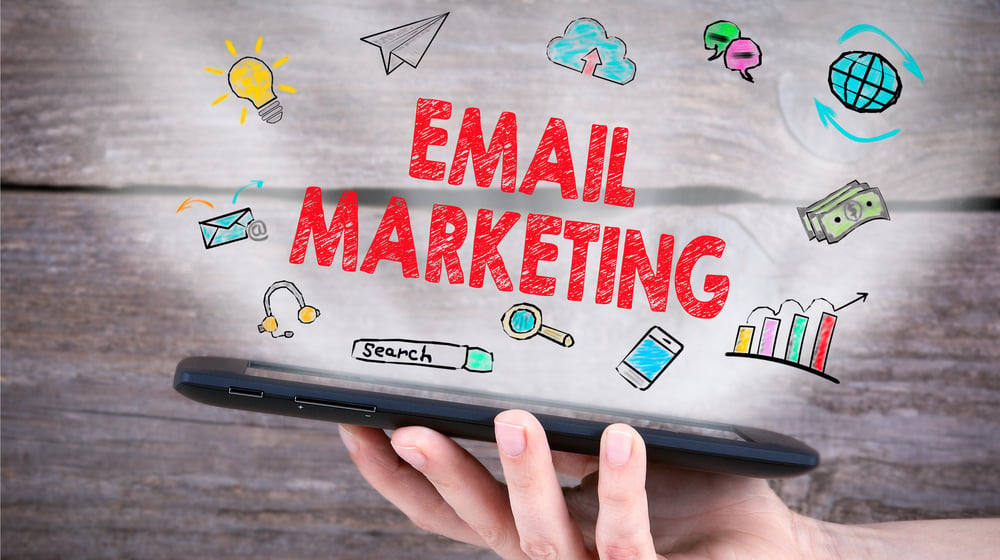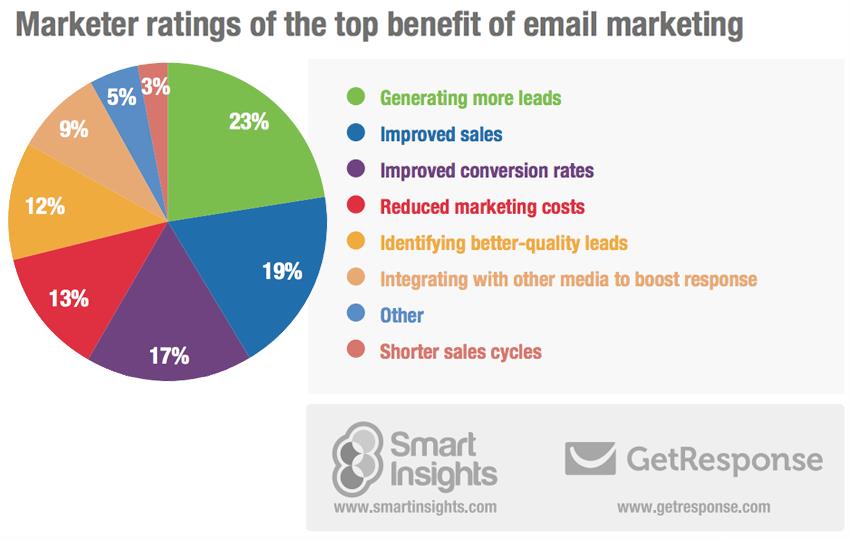||

The numbers show that email marketing is still a widely used, and successful, marketing channel.
However, your small business can use email marketing in many different ways. How do you choose your approach? One way might be the following chart from the Email Marketing & Marketing Automation Excellence 2017 Report:

Source: Email Marketing & Marketing Automation Excellence 2017 Report
Top Benefits of Email Marketing
The chart illustrates the seven top benefits of email marketing (ignoring “Other”), each of which is a worthy goal depending on what your small business is aiming to achieve.
1. Generating More Leads
Encouraging visitors to sign up for your email marketing list is just one way to generate more leads. Another strategy is to encourage your email subscribers to forward your emails on to friends, families, and acquaintances or to share it on social media.
2. Improved Sales
If every subscriber on your list turned into a customer, you’d be in small business heaven. Unfortunately, that’s probably never going to happen. However, you can increase your sales by focusing the right email campaigns on the right people. The secret to doing this is email list segmentation, a process that enables you to nurture each of your list subscribers with the right message at the right time, eventually moving each through your funnel to becoming a customer.
3. Improved Conversion Rates
In order to sell, you need to convert and the key to email conversions is to nurture them using content. Like #2 above, the key lies in email list segmentation however, it helps to know what type of content to use at each stage of the sales process. Once you nail that, your nurturing efforts will be much more effective and, your overall conversion rates will increase.
4. Reduced Marketing Costs
If your small business marketing budget is tight, you’ll be interested in low-cost ways to promote yourself. Happily, there are a lot of email marketing tools out, many of which offer a free tier of service and low prices when you need more features and functionality.
5. Identifying Better-Quality Leads
The last thing you need is to waste time on bad leads. That’s why, before marketing your small business, it pays to have a lead qualifying system in place. Happily, email marketing itself is a lead qualifying system that demonstrates a prospect’s interest based on:
- The fact that they signed up for your list in the first place;
- Whether they open your emails; and
- If they click on any of the links within your emails.
6. Integrating with Other Media to Boost Response
Integrated marketing is a powerful tool in any marketer’s kit. One of the best integrations for email is with social media where your emails can include:
- Social share icons;
- Super-sharable content; and
- Deals to share which then give a referral reward back to the subscriber who shared it.
7. Shorter Sales Cycles
Email marketing is a great way to get your most convincing content in front of prospective decision makers. If you’re nurturing the right subscribers via email as mentioned in No. 5 above, and you’re using both segmentation and the right content as mentioned in No. 2 and No. 3 above respectively, then you can speed up your sales cycle by getting the right content to the right decision maker at the right time.
| Benefits of Email Marketing | Description |
|---|---|
| 1. Generating More Leads | Encourage website visitors to sign up for your email list. Utilize strategies like encouraging subscribers to forward emails to expand your reach. Promote sharing on social media to attract new leads. |
| 2. Improved Sales | Increase sales by targeting the right audience with tailored email campaigns. Implement email list segmentation to nurture subscribers with the right messages at the right time. Move leads through the sales funnel effectively. |
| 3. Improved Conversion Rates | Focus on nurturing leads through content. Leverage email list segmentation to deliver the appropriate content at each stage of the sales process. Enhance overall conversion rates by delivering relevant messages. |
| 4. Reduced Marketing Costs | Opt for cost-effective email marketing tools, many of which offer free or budget-friendly tiers. Maximize your marketing budget by utilizing affordable email marketing resources. |
| 5. Identifying Better-Quality Leads | Use email marketing to qualify leads based on their actions, such as subscribing to your list, opening emails, or clicking on links. Identify leads with genuine interest in your offerings. Avoid wasting time on uninterested prospects. |
| 6. Integrating with Other Media to Boost Response | Leverage integrated marketing strategies, particularly with social media. Incorporate social share icons, shareable content, and referral reward deals in your emails. Encourage subscribers to share your content, expanding your reach through various media channels. |
| 7. Shorter Sales Cycles | Speed up the sales cycle by delivering compelling content to the right decision-makers. Utilize email nurturing for subscribers, segmenting your list, and delivering tailored content. Provide decision-makers with relevant information at crucial moments, expediting the sales process. |

Enhancing Your Email Marketing Strategy
While email marketing offers a multitude of benefits, there are additional ways to enhance your strategy and achieve even better results. Consider these advanced tactics to take your small business email marketing to the next level:
- Behavior-Based Automation: Implement behavior-based automation sequences that respond to your subscribers’ actions. For instance, send personalized follow-up emails when a subscriber engages with specific content or exhibits particular behavior on your website.
- Dynamic Content: Utilize dynamic content in your emails to tailor messages based on each recipient’s preferences and behavior. Delivering highly relevant content increases engagement and conversion rates.
- Segmentation Refinement: Go beyond basic segmentation and create more refined audience segments. Consider factors like purchase history, engagement frequency, and product preferences to deliver hyper-targeted content.
- Personalized Recommendations: Incorporate personalized product recommendations based on each recipient’s browsing and purchase history. Suggesting products or services relevant to their interests can boost sales.
- A/B Testing: Continue experimenting with A/B testing, not only in email subject lines but also in email content, visuals, and CTAs. Test different elements to determine the most effective combinations.
- Advanced Analytics: Dive deeper into your email analytics to gain insights into subscriber behavior. Analyze click maps, heatmaps, and conversion paths to optimize your email campaigns further.
- Predictive Analytics: Explore the use of predictive analytics to forecast customer behavior. Predictive models can help you identify potential high-value customers and tailor your strategies accordingly.
- Mobile Optimization: Ensure your emails are mobile-optimized, considering responsive design and mobile-friendly content. Mobile users represent a significant portion of your audience, and a seamless mobile experience is crucial.
- Personalized Surveys: Use personalized surveys within your emails to gather valuable feedback from your subscribers. This data can inform product development, content creation, and customer satisfaction improvements.
- Drip Campaigns: Develop advanced drip campaigns that nurture leads over an extended period. Deliver a series of highly relevant emails to guide leads through the decision-making process.
- Retargeting Emails: Implement retargeting emails to reengage visitors who abandoned your website or shopping cart. These emails can help recover potentially lost sales.
- AI-Powered Content Generation: Explore the use of AI-powered tools for content generation. AI can assist in creating personalized and relevant content at scale.

Crafting Compelling Email Subject Lines
The subject line of your email is the first impression you make on recipients. It plays a pivotal role in whether your email gets opened or ignored. To maximize the impact of your email marketing efforts, consider these tips for crafting compelling subject lines:
- Be Clear and Concise: Keep your subject lines brief and to the point. Avoid ambiguity and clearly convey the email’s content or purpose.
- Create a Sense of Urgency: Use words and phrases that create a sense of urgency, such as “Limited Time Offer” or “Act Now.” Urgency can prompt recipients to open your email quickly.
- Personalization: Incorporate personalization elements, such as the recipient’s name or location, to make the email feel tailored to their needs.
- Ask a Question: Pose a compelling question that piques recipients’ curiosity and encourages them to open the email for answers.
- Highlight Benefits: Emphasize the benefits or value recipients will gain by opening the email. Make it clear how the email’s content will improve their lives or solve a problem.
- Use Emojis Sparingly: Emojis can add visual appeal to subject lines, but use them sparingly and ensure they align with your brand and message.
- Avoid Spammy Language: Steer clear of spammy language, excessive capitalization, or excessive exclamation marks. Such tactics can trigger spam filters and deter recipients.
- Segmented Subject Lines: Tailor subject lines to specific audience segments. Segmenting your list allows you to create subject lines that resonate with different groups.
- Test and Iterate: Conduct A/B tests on subject lines to determine which ones perform best. Continuously refine your approach based on the results.
- Tease Content: Give recipients a glimpse of the valuable content or offer waiting inside the email. Create curiosity without revealing everything upfront.
- Stay Relevant: Ensure that your subject line aligns with the email’s content. Misleading subject lines can lead to unsubscribes and a damaged reputation.
- Avoid All Caps: Avoid using all capital letters in your subject lines, as it can come across as shouting and decrease open rates.
- Preview Text: Consider the preview text that accompanies the subject line. It should complement and provide additional context to the subject.
- Mobile Optimization: Keep in mind that many recipients view emails on mobile devices. Test subject lines to ensure they display well on small screens.
- Test Length: Experiment with different subject line lengths. Sometimes a concise subject line works best, while other times a longer, informative one is more effective.
| Subject Line Crafting Tips | Description |
|---|---|
| Be Clear and Concise | Keep subject lines brief and straightforward, avoiding ambiguity. Clearly convey the email's purpose. |
| Create a Sense of Urgency | Use urgency-inducing words and phrases like "Limited Time Offer" to encourage quick email opens. |
| Personalization | Include personalization elements, like the recipient's name or location, for a tailored feel. |
| Ask a Question | Pose compelling questions that spark curiosity and entice recipients to open for answers. |
| Highlight Benefits | Emphasize the benefits or value recipients will gain from opening the email. |
| Use Emojis Sparingly | Add emojis for visual appeal, but ensure they align with your brand and message. |
| Avoid Spammy Language | Steer clear of spammy language, excessive capitalization, and exclamation marks that deter recipients. |
| Segmented Subject Lines | Tailor subject lines to specific audience segments to resonate with different groups. |
| Test and Iterate | Conduct A/B tests to refine subject lines based on performance results. |
| Tease Content | Offer a glimpse of valuable content or offers inside the email to create curiosity without revealing all. |
| Stay Relevant | Ensure subject lines align with the email's content to avoid misleading recipients. |
| Avoid All Caps | Refrain from using all capital letters in subject lines to prevent sounding like shouting. |
| Preview Text | Consider the preview text that complements and provides context to the subject line. |
| Mobile Optimization | Test subject lines for readability on mobile devices, as many recipients view emails on small screens. |
| Test Length | Experiment with different subject line lengths, choosing concise or informative based on effectiveness. |

Maximizing Email Deliverability
Ensuring that your emails reach the intended recipients’ inboxes is vital for the success of your email marketing campaigns. Here are essential strategies to enhance email deliverability:
- Use a Reputable Email Service Provider (ESP): Select a trusted ESP with a good track record of delivering emails to inboxes. Reputable ESPs have established relationships with ISPs and email providers, improving your chances of inbox placement.
- Authenticate Your Domain: Implement authentication protocols like SPF (Sender Policy Framework), DKIM (DomainKeys Identified Mail), and DMARC (Domain-based Message Authentication, Reporting, and Conformance) to verify your domain’s legitimacy. Authentication helps prevent email spoofing and phishing.
- Maintain a Clean Email List: Regularly clean your email list to remove inactive or invalid addresses. High bounce rates and spam complaints can harm your sender reputation.
- Follow Double Opt-In Procedures: Encourage subscribers to confirm their email subscriptions through a double opt-in process. This confirms their consent and reduces the likelihood of spam complaints.
- Monitor Sender Reputation: Keep an eye on your sender reputation using tools provided by your ESP. A strong sender reputation increases the chances of inbox placement.
- Segment Your Email List: Segment your email list based on subscriber behavior, preferences, and engagement. Send relevant content to specific segments to reduce the risk of unsubscribes and spam complaints.
- Monitor Engagement Metrics: Pay attention to email engagement metrics such as open rates, click-through rates, and conversion rates. ISPs often consider engagement when deciding whether to deliver emails to inboxes or spam folders.
- Avoid Spam Triggers: Steer clear of spammy content and practices. Avoid using excessive exclamation marks, all caps, or misleading subject lines. Provide a clear unsubscribe option.
- Set Expectations: Clearly communicate what subscribers can expect when they sign up for your emails. Set frequency expectations and deliver the content you promised.
- Warm Up New IP Addresses: If you’re switching to a new ESP or IP address, warm it up gradually by sending emails in smaller volumes initially. This helps establish a positive sender reputation.
- Test Send Times: Experiment with the timing of your email sends to determine when your audience is most likely to engage with your messages. A/B testing can help identify optimal send times.
- Monitor Blacklists: Regularly check email blacklists to ensure your IP or domain isn’t listed. Being on a blacklist can significantly impact email deliverability.
- Provide Clear Unsubscribe Options: Make it easy for recipients to unsubscribe from your emails. Complying with unsubscribe requests promptly can prevent spam complaints.
- Regularly Update Contact Information: Ensure that your contact information, including a physical mailing address, is accurate and up-to-date in every email you send.
- Stay Informed About Industry Changes: Keep abreast of evolving email industry standards and regulations. Compliance with laws like GDPR and CAN-SPAM is essential.
Email Marketing Photo via Shutterstock
This article, "The Top 7 Benefits of Email Marketing (Pay Close Attention to No. 5)" was first published on Small Business Trends
||----------------------------------------------------------------
By: Matt Mansfield
Title: The Top 7 Benefits of Email Marketing (Pay Close Attention to No. 5)
Sourced From: smallbiztrends.com/2023/10/benefits-of-email-marketing.html
Published Date: Tue, 10 Oct 2023 06:30:41 +0000






